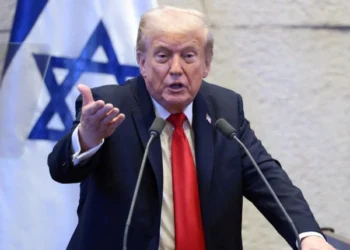Ceasefire Agreement Marks New Era of Trade, Technology Cooperation, and Regional Stability
In a landmark diplomatic breakthrough, United States President Donald Trump successfully mediated a historic peace agreement between Azerbaijan and Armenia, putting an official end to decades of hostility and bloodshed between the two nations. The deal, signed at the White House, commits both sides to a complete ceasefire while paving the way for expanded trade relations, technology partnerships, and economic growth.
The agreement is being hailed as a significant diplomatic victory, not only for the South Caucasus region but also for the United States’ role in global conflict resolution. This event has the potential to reshape the geopolitical landscape of Eurasia and turn two long-time adversaries into economic partners.
The Signing Ceremony at the White House
The historic signing took place in Washington, D.C., with Azerbaijani President Ilham Aliyev and Armenian Prime Minister Nikol Pashinyan seated alongside President Trump. The atmosphere at the White House was markedly different from the bitter rhetoric and military clashes of the past. Smiles replaced suspicion as the two leaders signed the document, signaling a new chapter in their nations’ relations.
President Trump, who personally witnessed the signing, addressed reporters at a joint press conference:
“Azerbaijan and Armenia have agreed to a ceasefire. From this day forward, their priority will not be war, but trade and mutual prosperity. I told both nations: stop fighting and start trading—and they have promised to do exactly that.”
Trump emphasized that the deal extends beyond military de-escalation, incorporating cooperation in technology, artificial intelligence, and infrastructure development. “We want peace and trade, not wars,” he added.
Key Points of the Peace Agreement
The peace deal contains several groundbreaking provisions that aim to ensure a long-lasting resolution to the decades-long Azerbaijan-Armenia conflict:
- Full Ceasefire – Both nations agree to halt all military activities immediately and refrain from hostile acts in the future.
- Trade and Economic Partnerships – A commitment to open markets, reduce trade barriers, and encourage bilateral investments.
- Technology and AI Cooperation – Joint projects in the fields of artificial intelligence, innovation, and digital infrastructure.
- Infrastructure Development – Agreements on transport connectivity, including rail and road links that would benefit both nations.
- US Oversight Role – The United States, as a mediator, will monitor the implementation of the agreement for at least five years.
A Conflict Rooted in History: The Nagorno-Karabakh Dispute
The rivalry between Azerbaijan and Armenia has deep historical roots, with the primary flashpoint being Nagorno-Karabakh, a mountainous enclave internationally recognized as part of Azerbaijan but home to a predominantly ethnic Armenian population.
- Late 1980s: As the Soviet Union began to collapse, ethnic tensions escalated, leading to a full-scale war.
- 1994 Ceasefire: Armenia emerged controlling Nagorno-Karabakh and surrounding Azerbaijani territories.
- 2020 War: A six-week conflict erupted, resulting in Azerbaijan regaining large parts of the disputed area through military victory.
- 2023 Developments: In October 2023, Azerbaijani forces carried out a military operation that led to the disarmament of separatist forces in Nagorno-Karabakh. The self-proclaimed government agreed to dissolve itself and integrate into Azerbaijan.
This long history of mutual distrust and violence has left deep scars, making the current peace deal even more remarkable.
Why This Deal Is Different from Previous Ceasefires
Over the past three decades, there have been numerous ceasefire agreements between Azerbaijan and Armenia, most of which were short-lived. However, this particular agreement stands out for several reasons:
- US Direct Mediation: Unlike previous Russia- or EU-brokered deals, this one was mediated directly by the United States, with Trump taking a personal role.
- Economic Incentives: The agreement is not just about halting hostilities; it provides clear economic benefits, giving both sides strong incentives to maintain peace.
- Technological Collaboration: By including joint AI and innovation projects, the deal shifts the focus toward future-oriented cooperation.
- Public Commitments by Leaders: Both Aliyev and Pashinyan made public pledges, increasing political accountability.
Statements from the Leaders
President Ilham Aliyev of Azerbaijan described the agreement as “a turning point in our history,” adding:
“We have fought for decades, but now we will work for decades to build a prosperous future together. The people of both nations deserve peace, stability, and opportunities for growth.”
Prime Minister Nikol Pashinyan of Armenia acknowledged that the deal required “difficult compromises,” but stressed that “peace is the only path forward” for future generations. He also highlighted the economic and technological benefits as a major incentive for Armenia’s participation.
Economic Potential of the Peace Agreement
Analysts believe that regional trade could skyrocket as a result of the deal. Both Azerbaijan and Armenia sit at a strategic crossroads between Europe and Asia, making them prime candidates for becoming transport and logistics hubs.
- Azerbaijan’s Strengths: Oil and gas exports, as well as growing investments in digital infrastructure.
- Armenia’s Strengths: A skilled IT workforce, agricultural products, and emerging tourism industry.
- Joint Opportunities: Development of AI-based projects, cross-border industrial zones, and renewable energy initiatives.
If implemented successfully, this cooperation could transform the South Caucasus into an economic powerhouse.
US Diplomatic Strategy and Global Reactions
The peace deal is also a diplomatic win for the United States. By mediating the agreement, the US has strengthened its influence in the Caucasus region, which has traditionally been a zone of competition between Russia, Turkey, and Iran.
- Russia’s Response: Cautious but supportive, emphasizing the need for stability.
- European Union’s Stance: Welcomed the deal as a positive step toward regional integration.
- Turkey’s Position: Strongly supportive, given its close ties with Azerbaijan.
- Iran’s Reaction: Reserved, highlighting the need for “balanced foreign involvement” in the region.
Challenges Ahead: Can the Peace Last?
While optimism is high, experts caution that sustaining peace will require consistent effort from all parties. Potential challenges include:
- Public Skepticism – Decades of war have left deep mistrust among citizens of both nations.
- Political Opposition – Hardliners in either country could resist full cooperation.
- External Influence – Regional powers with vested interests may try to disrupt the peace process.
However, the economic and technological benefits outlined in the deal could serve as strong incentives to keep both nations committed.
A Turning Point for the South Caucasus
This agreement represents more than just a ceasefire—it is an opportunity to rewrite the future of an entire region. If Azerbaijan and Armenia honor their commitments, the South Caucasus could evolve from a conflict zone to a thriving corridor of trade, innovation, and cooperation.
President Trump summed up the historic moment during the press conference:
“History will remember this day as the moment two nations chose prosperity over conflict. This is not just peace between Azerbaijan and Armenia—it’s a victory for peace itself.”

























